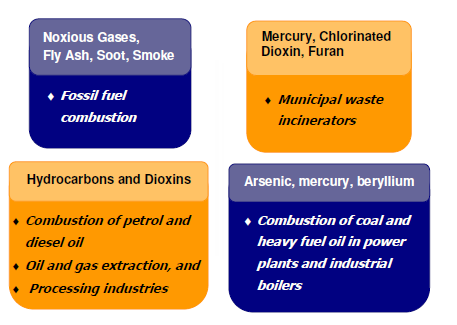Air Pollution
Various hazardous air pollutants apart from GHGs are emitted in energy- associated activities. Fossil fuel combustion generates smoke and noxious gases such as sulphur dioxide, nitrous oxide and carbon monoxide, as well as particulates like fly ash and soot. These are the main atmospheric pollutants. Other air pollutants and their sources in the energy sector are display in Figure.
Air pollutants cause several health problems, particularly amongst children, the elderly people, and those along with respiratory diseases. These could even be fatal as reported in various studies. Ingestion of heavy metal pollutants, including lead, arsenic, and mercury from the burning of coal and oil could even cause cancer. These effects can be mitigated through
- Limiting people's exposure to the pollutants;
- Appropriate sitting of the power producing plants as well as large energy consuming facilities such as industrial plants;
- Installation of pollution control devices on polluting vehicles and industries; and
- Enforcement of stringent emission regulations and air quality norms.

Figure: Air Pollutants and Their Sources in the Energy Sector
We now know which approximately two-thirds of the deaths because of fine particle pollution from power plants could be prevented through reducing their sulphur dioxide and nitrogen oxide emissions through 75% below the 1997 emission levels. Therefore, some of the polluting by-products could be put to good use. For example, fly ash is being used to make construction materials like bricks, tiles, etc.